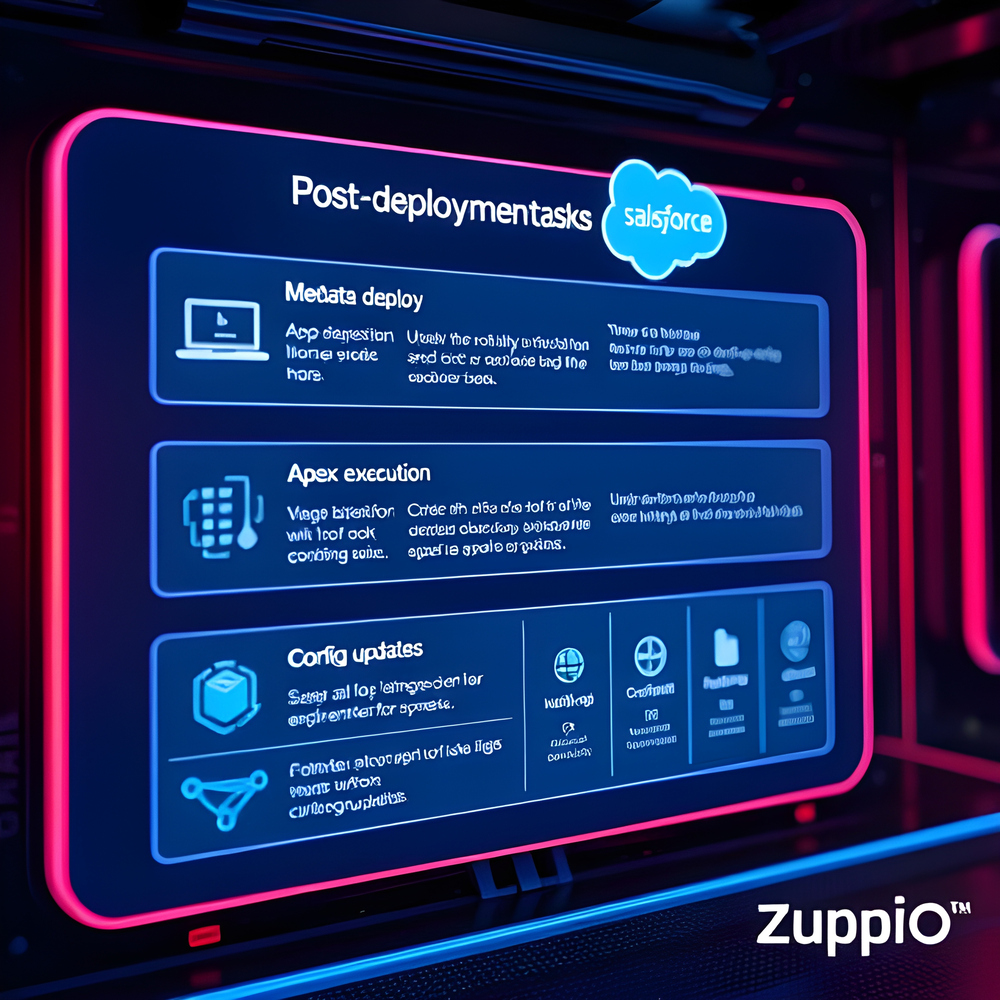Post-Deployment Automation with ZuppIO: Apex, Permissions, Configuration — All in One Job

Introduction to Post-Deployment Challenges in Salesforce
Post-deployment tasks are often the silent burden of Salesforce release cycles. While deploying metadata or packages is critical, what follows the initial deployment is equally important for operational readiness. These activities include executing Apex scripts, configuring system components, assigning permissions, and verifying post-install outcomes. Traditionally, such tasks require manual effort, often spread across multiple orgs, leading to delays, inconsistencies, and a lack of accountability.
In large-scale Salesforce environments, especially those involving managed packages, ISV rollouts, or multi-org structures, these post-deploy steps become mission-critical. Delayed Apex execution or unassigned permission sets can cause features to fail, users to lose access, or business logic to break. As complexity grows, relying on CLI scripts or Change Sets becomes unsustainable.
ZuppIO addresses these challenges through a robust, visual Job system that allows teams to chain deployment tasks with post-deploy logic in a single controlled flow. This functionality turns post-deployment from a manual scramble into a structured, auditable, and automated routine.
How ZuppIO Structures Post-Deploy Workflows
ZuppIO’s automation engine treats post-deployment activities as first-class citizens in the deployment lifecycle. Rather than requiring external scripting or chained jobs in Jenkins, users can configure sequential Steps directly within a ZuppIO Job. These Steps may include metadata deployment, Apex execution, data population, configuration updates, or any combination thereof.
Each Step can target one or more Salesforce orgs, with full control over execution order, error handling, and logging. The visual UI enables drag-and-drop sequencing, making complex job flows easy to create and maintain without writing code.
Key structural elements of a post-deploy Job in ZuppIO include: • Deployment Step — Metadata or package install.
• Apex Step — Run anonymous Apex scripts post-deploy.
• Configuration Update Step — Modify Layouts, Tabs, Picklists, etc.
• Verification Step — Log results, compare expected vs. actual.
All these actions can be executed in sequence, across dozens of orgs, with rollback and dry-run support where applicable. This architecture provides the flexibility needed for enterprise release governance without requiring low-level intervention.
Automating Apex Execution Across Multiple Environments
Apex remains the backbone of business logic in Salesforce, and its execution after deployment often activates new functionality, inserts default records, or performs cleanup operations. Manually logging into each org to run anonymous scripts is inefficient and error-prone.
ZuppIO simplifies this by embedding Apex Steps into the Job flow. These scripts can be inserted inline, or — optionally — sourced from version-controlled repositories such as Git. Once defined, Apex Steps execute in the same controlled environment as metadata deployments, inheriting org targeting, logging, and execution history.
Key benefits of automated Apex execution with ZuppIO: • Parallel execution across multiple Salesforce orgs.
• Centralized script management — no more per-org manual entry.
• Optionally source scripts from version-controlled repositories.
• Error capture with detailed logs and checkpoints.
For example, a deployment that includes a new custom object might also execute a post-deploy Apex Step that populates default records, sets field values, or schedules future jobs. This tight integration between code and config ensures that deployments result in usable features, not just metadata transfers.
Managing Access Provisioning via Apex
User access management is often part of post-deployment operations, especially when newly deployed functionality requires specific permissions. While ZuppIO does not currently offer dedicated UI steps for assigning Permission Sets or Profiles, these tasks can be automated using Apex logic within a Job.
Many teams use Apex Steps to assign permissions programmatically, for example by invoking System.UserManagement.assignPermissionSets() or similar patterns within Salesforce’s supported APIs. This gives developers full control over access provisioning while maintaining ZuppIO’s visual orchestration and logging.
Advantages of using Apex for access provisioning: • Define and track access logic in version-controlled scripts.
• Eliminate manual errors in critical access assignments.
• Ensure consistent access across environments via repeatable logic.
• Maintain audit trails of who received what, when, and how.
This method is especially effective in ISV and compliance-heavy contexts, where access changes must be automated, logged, and reversible.
Updating Configurations and Metadata After Deployment
Beyond Apex and access, many Salesforce deployments require follow-up changes to metadata structures — for example, modifying page layouts, picklist values, Lightning record pages, or activating flows. ZuppIO supports these actions through additional Step types that allow for post-deploy adjustments in the same Job.
This removes the need to track separate admin tickets, spreadsheets, or follow-up tasks. Admins or release managers can define the configuration changes upfront and execute them as part of the deployment flow.
Examples of supported post-deploy config updates: • Assigning new fields to Page Layouts
• Adding values to Global Picklists
• Updating Custom Metadata records
• Changing component visibility in Lightning Pages
• Enabling flows or process builders
With centralized logging and history tracking, these adjustments become traceable, repeatable, and version-aware. This end-to-end automation eliminates the “now go do the rest” phase that typically follows deployments.
Conclusion: ZuppIO as a Full-Cycle Deployment Engine
ZuppIO doesn’t just automate deployment — it orchestrates the full lifecycle, from metadata delivery to post-deploy operations. By embedding Apex execution, access provisioning via Apex, and config updates into a single Job, teams reduce handoffs, human error, and post-release downtime.
This approach is particularly valuable in large, multi-org Salesforce programs or ISV rollouts, where release quality, reproducibility, and auditability are non-negotiable. ZuppIO’s unified UI and execution engine provide the transparency and control needed to support enterprise DevOps workflows.
Whether you’re deploying a small change set or a multi-package release across hundreds of orgs, ZuppIO ensures everything after deployment just works — no scripts, no follow-ups, just clean, complete delivery.